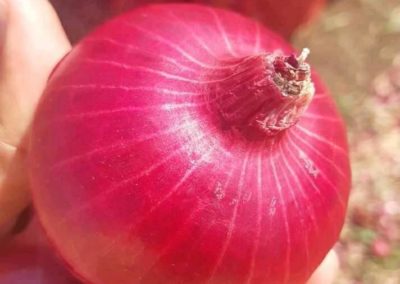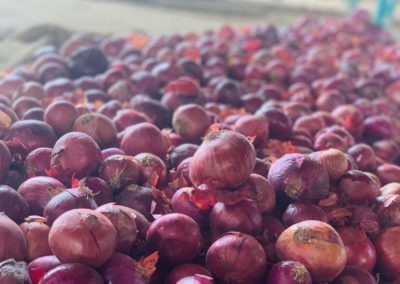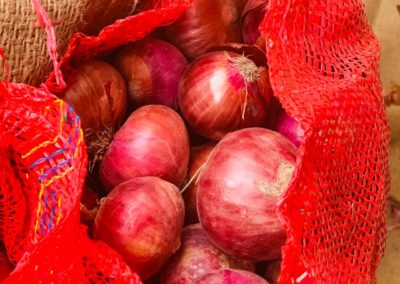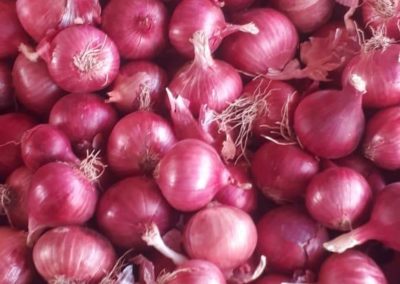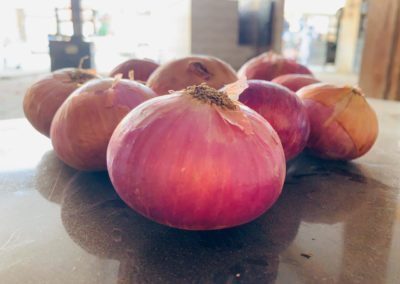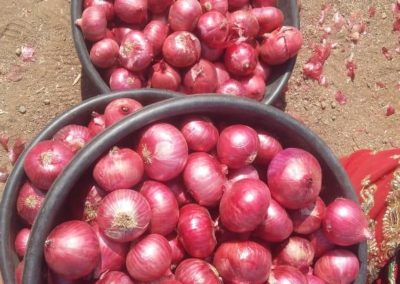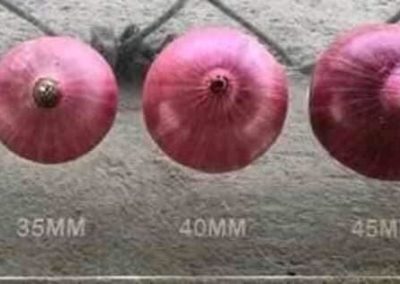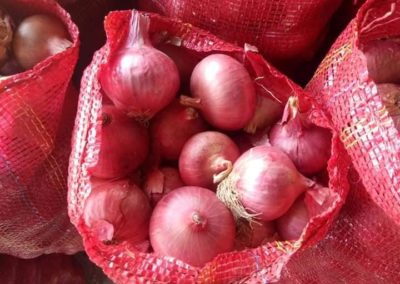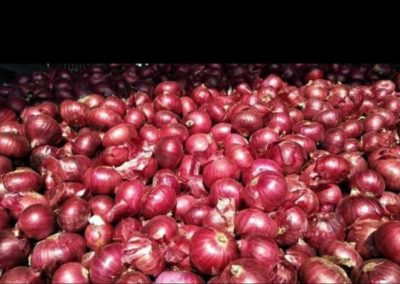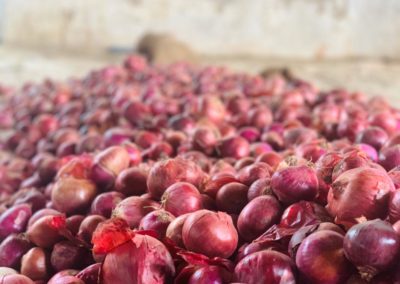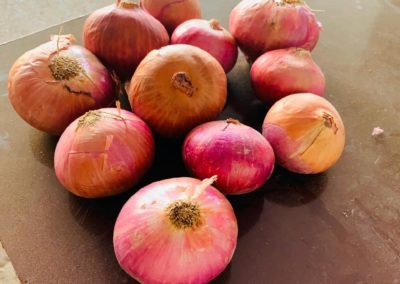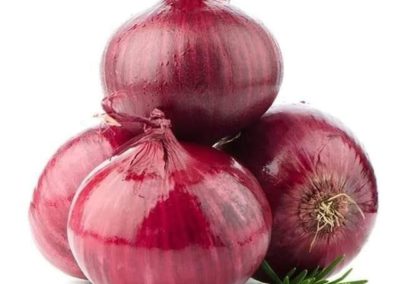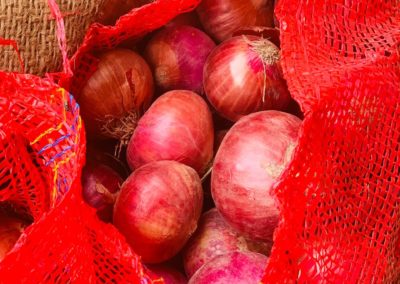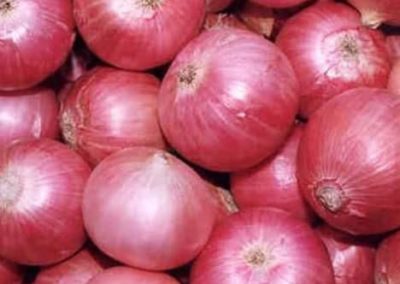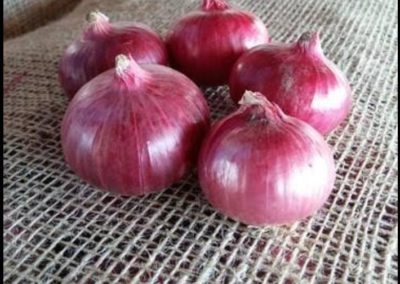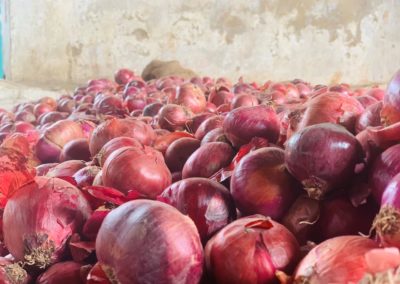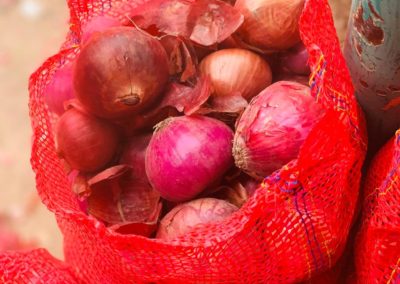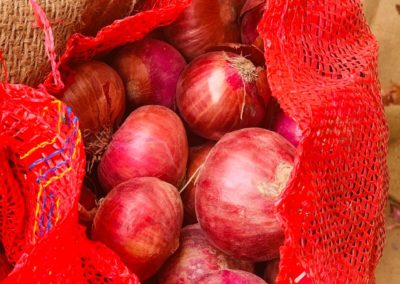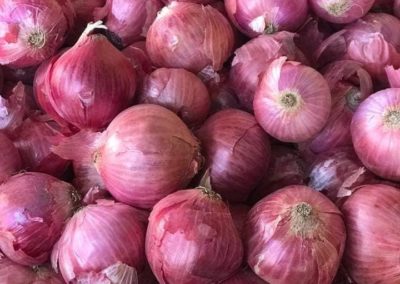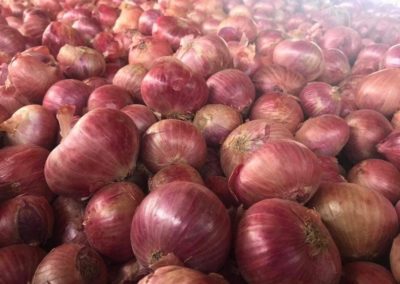Onion Harvesting
GROWING ONION IN PAKISTAN
Introduction and Importance
Onion (Allium cepa L) is one of the important condiments widely used in all households through the year. Onions may be eaten raw, fried and pickled. The green leaves and immature and mature bulbs are eaten raw or used in preparation of vegetables. Onions are used in soups, sauces and for seasoning foods. The small bulbs are pickled in vinegar. Recent research has suggested that onions in the diet may play a part in preventing heat stroke and other ailments. Onion bulb is rich in phosphorus, calcium and carbohydrates. The composition of onion bulb is given in table 1. The pungency in onion is due to a volatile oil known as allyl-propyl disulphide.
Table 1. Composition of Onion Bulb* (per 100 g of edible portion)
| Moisture | 86.8 g | Vitamin C | 11.0 mg |
| Carbohydrates | 11.0 g | Calcium | 180 mg |
| Protein | 1.2 g | Phosphorus | 50 mg |
| Fibre | 0.6 g | Iron | 0.7 mg |
| Minerals | 0.4 g | Nicotinic acid | 0.4 mg |
| Thiamine | 0.08 mg | Riboflavin | 0.01 mg |
*Aykroyd, (1963)
Onion is commercially grown on an area of 131.4 thousand hectares with the production of 1.8 million tones (Table 2). The major onion growing districts are Kasur and Vehari, in Punjab; Hyderabad, Sanghar, Mirpurkhas, Nawabshah, Dadu , Badin, N. Feroze, Ghotki and Shikarpur in Sindh; Swat and Dir in NWFP and Chaghi, Kharan, Kalat, Nasirabad, Mastung, Killa Saifullah, Khuzdar, Turbat and Jaffarabad in Balochistan. These 22 districts account for more than 77 percent of the total production of onion in Pakistan. More than 50 percent of the total production comes from eight districts namely Hyderabad, Sanghar, Mirpurkhas, Nawabshah, Swat, Chaghi, Kharan and Kalat. Top ten onion producing districts are Chaghi, Hyderabad, Sanghar, Swat, Kharan, Kalat, Mirpurkhas, Nawabshah, Nasirabad and Dir contributing more than 59% of total production. The total production of onion from Punjab is equivalent to the total production of two districts of Balochistan (Chaghi and Kharan). Hyderabad and Sanghar districts of Sindh produce 3% more than that of whole Punjab.
Table 2. Status of onion (province-wise) 2006-07
| Province |
Area (‘000’ Hectares) |
% share | Production (‘000’Tonnes) | % share |
Average Yield t/ha |
Punjab |
35.6 | 27 | 315.7 | 17 | 8.9 |
| NWFP | 12.0 | 9 | 206.1 | 11 | 17.2 |
| Sindh | 45.6 | 35 | 593.1 | 33 | 13.0 |
| Balochistan | 38.2 | 29 | 701.6 | 39 | 18.4 |
| Pakistan | 131.4 | 1816.5 | 13.8 |
Top ten onion producing districts are Chaghi, Hyderabad, Sanghar, Swat, Kharan, Kalat, Mirpurkhas, Nawabshah, Nasirabad and Dir contributing more than 59% of total production. The total production of onion from Punjab is equivalent to the total production of two districts of Balochistan (Chaghi and Kharan). Hyderabad and Sanghar districts of Sindh produce 3% more than that of whole Punjab.
Production Methods
The most distinct methods of planting onions include (1) sowing seed directly in the field where the crop is to mature; (2) sowing in a seedbed from which the plants are transplanted later to the field; and (3) planting sets. A grower may buy these sets, or grow them from seed himself. The transplanting method is used more commonly for early production.
Autumn crop
Onion is grown throughout Pakistan in varying volumes and with different harvesting periods (Table 3). However, supply of onion falls in short of requirements from December-January and prices soar to more than five times compared with normal season. The nursery for autumn crop of onion is raised in first week of July and the seedlings are transplanted in the field in the middle of August for harvesting of bulbs during December. It is difficult to manage nursery seedlings of autumn crop because of high temperature and monsoon rains. Sometimes, the heavy rains cause severe damage to nursery seedlings. This difficulty can be overcome through direct planting of onion sets and to eliminate the step of nursery raising which is not only time consuming but laborious as well. All varieties of onion are not suitable for autumn crop. Furthermore, size of onion set is closely related to subsequent bulb yield. During 1999-2005, work on off-season/ autumn crop of onion production through sets was conducted at NARC. Phulkara variety of onion was found most suitable for autumn season cultivation. Set size in the range of 17-21 mm diameter produced the highest marketable bulb yield of onion.
Table 3. Planting and harvesting times of onion
|
Province
|
Nursery Sowing | Transplanting | Harvesting |
| Punjab | October/November | December/January | May-June |
| KPK | October | December/January | June/July |
|
(Lower Sindh) (Uper Sindh) |
June-September October-December |
July-October November-February |
October-February March-May |
| Baluchistan | – |
February-March (Direct Seeding) |
September-November |
Current National Problems:
- Identification of suitable varieties for short to intermediate days, high yield with better storage quality.
- Inadequate supply of good quality seed
- Hoeing and weeding for control of weeds in onion crop is very expensive.
- Considerable damage is done to onion crop by thrips, purple blotch and downy mildew.
- Phosphorus and potash fertilizers are rarely used by the farmers. As a result the bulbs have very poor storage quality.
- Marketing of surplus produce of onion during the year of over production is a great problem.
Bulbing and Bolting
Bulbing in onions is primarily a response to longer days and shorter nights. Bulbing in short-day cultivars occurs when a critical day length longer than 10 to 11 hours is reached. Onion plants require a certain amount of leaf tissue before they respond to day length and until that time, they behave as immature plants and produce only leaves. Once sufficient leaf tissue has developed, onion plants can perceive the bulbing stimulus and will bulb if the day length is long enough. If planted late enough in the fall, onion plants will not have enough foliage to react to the fall bulbing stimulus. As the days become shorter in the fall (shorter than the critical 10 to 11 hours), those onions will produce leaves continuously. This is evidenced by their winter growth habit. After initiation, bulbs will develop more rapidly with warm temperatures and good watering practices.
Bolting occurs when the onion produces a flower and it results in a seed head. Bolting is also referred to as hard stems, seed stems, or buttoning. The process is influenced mainly by temperature, plant size and variety. Some onion varieties are quite resistant to bolting. Bolting is almost entirely induced by cool temperatures and is not affected by day length. Once onion plants reach a certain size, (usually 7 to 10 leaves), exposure to low temperature for a period of two to three weeks usually causes some bolting. Longer cold exposure results in a greater percentage of bolting.
Temperature and Photoperiod
Onion is a cool season plant, its optimum temperature for seed germination ranges from 20-25 0C, early growth stages before bulbing require 13 to 20 0C and bulb development needs 16 to 25 0C. At low temperature, bulbing takes place very slowly and if the temperature is very low, no bulbing takes place. At low temperature onions are more inclined to bolt.
Photoperiod plays critical role on bulb development and also determines the suitability of a cultivar for a particular region. Onion cultivars are classified into short, intermediate and long day types according to the minimum day length needed to stimulate bulb development. Onion varieties adapted to tropics only form bulbs when grown in areas having 10 to 12 hours of day light (short day types onion) but varieties adapted to the sub-tropics require somewhat long day lengths from 13 to 14 hours (intermediate day types onion) to initiate bulb formation. The long day types require above 16 hours for bulb formation and are not suitable in our environmental conditions. Only short to intermediate day length types respond well. Therefore, for successful production of onions it is imperative to select the suitable varieties for each agro-ecological region.
Varieties
Onions start bulb formation when the day length is of the proper duration and different varieties of onions require different day lengths to initiate bulbing. In general, most common varieties fall into one of two classes, long-day (for northern latitudes) and short-day (for southern latitudes). For this reason, onion varieties that are grown in the South are not adaptable to the North and vice versa. During 1999-2005, work on off-season/ autumn crop of onion production through sets was conducted at NARC. Onion varieties grown in Pakistan are given in table 4. Phulkara which is a short- day variety was found most suitable for autumn season cultivation.
Onion varieties grown in Pakistan are given in table 4.
Table 4. Onion Varieties Grown in Pakistan
| Province | Varieties |
| Sindh | Phulkara* |
| Punjab | Desi Red, Phulkara |
| Balochistan | Sariab Surkh, Chiltan-89 |
| NWFP | Swat-1 |
- Suitable variety for off-season production
Soil
Onion can be grown on a wide range of soils preferably sandy rich loam, well drained containing sufficient organic material to retain soil moisture for proper growth. Soil with pH from 6 to 7 is suitable for optimum crop growth. Hard soils induce the bulbs to be small and irregular in shape. Adequate quantity of manure and fertilizer is necessary for successful onion production.
Land Preparation
Proper land preparation is very important to ensure a uniform stand and higher onion bulb yield which can be achieved following below mentioned practices.
- Shred litter from previous crops with a rotary mower and disc into top few inches of soil as soon as possible.
- Deep-turn soil at least three to four weeks prior to planting, using a moldboard plough so that all litter will be buried at least eight inches deep.
- The soil should be ploughed to depth of 15 to 20 cm and one or two planking are sufficient to get good tilth and leveled seedbed.
- Rough and lumpy ground is not suited to the planting of onion seeds/seedlings/sets. Land must be leveled in order to irrigate the plants properly.
- Although onion has limited root system but is very responsive to manures and commercial fertilizers. Well-rotten farmyard manure @ 10 tones per acre should be ploughed down at the time of land preparation at least one month before land preparation. Before transplanting 3 bags of super phosphate, one bag of ammonium sulphate and one bag of potassium sulphate per acre should be thoroughly mixed in the soil.
Spacing
Onions are usually transplanted in the field at 10 cm plant-to-plant spacing and 25 cm apart in rows on flat beds. Space the plants 10 cm apart in the row to produce large-sized bulbs (closer spacing significantly decreases bulb size). Keep onions free from weeds by shallow cultivation and hoeing.
Fertilization
A supplementary dose of one bag of ammonium sulphate per acre should be applied one month after planting. Another dose of one bag of ammonium sulphate may be applied at the time of bulb formation. Generally excess of nitrogen causes onion bulbs to become less firm. Similarly, late application of nitrogen as top-dressing should be avoided, as it causes thick-necked bulbs. A good combination of potash and phosphate promotes firmness of bulbs and regular ripening.
Nitrogen
Nitrogen especially in nitrate form is extremely leachable. If too little nitrogen is available, onions can be severely stunted and more susceptible to diseases. High nitrogen application rates produce a succulent plant that is more susceptible to the production of flower stalks. Onions highly fertilized with nitrogen do not store well. Excess nitrogen late in the growing season delays maturity and causes doubling.
Phosphorus
Phosphorus is essential for rapid root development. It is found in adequate levels in most soils but is not very available at low soil temperatures. Because of these factors, it is best to band at least part of the phosphorus about three inches below and to the side of the transplant at setting.
Potassium
Potassium if applied in a concentrated band near the plant can result in damage and stand reduction. Potassium is also subject to leaching from heavy rainfall or irrigation. Apply potassium in small amounts throughout the growth of onions.
Nutrient Deficiency Symptoms of Onion
Nitrogen
- Leaves are light green
- Older leaves die, showing bleached yellow color
- Leaves are small
Phosphorus
- Older leaves wilt
- Tip die back
- Green areas are mottled
- Dead leaves turn black
Potassium
- Older leaves first show slight yellowing
- Leaves wilt and die; drying begin at tips of older leaves
- Poor bulb formation
Irrigation
The onion has a shallow root system, with most of its roots in the top 12 inches of soil. An onion continues to produce new roots (three or four per week) throughout the entire growing season as older roots die. Root growth is most active during early plant growth. Proper soil moisture is critical for continuous root growth and for supplying the needs of the foliage and bulb. Make sure good soil moisture exists before and after seeding, transplanting or setting sets. Prior to emergence and during the first three weeks of seedling growth, it is essential that adequate moisture be maintained in the top three to four inches of the soil. The first irrigation is given immediately after sowing and transplanting. Thereafter, onions are usually irrigated after ten days interval which can be increased or decreased according to climatic conditions. Irrigation must be discontinued before neck fall, to allow the bulbs to ripen off. Over-watering just before harvest can increase disease, splits and doubles.
Hoeing and Weeding
Weeds and grass compete with the onion plants for nutrients and moisture during the growing season. Onions have shallow roots and compete poorly with weeds and grasses. Timely shallow hoeing and cultivation are important, especially when the onions are small. Onion plant grows slowly during early growth stages therefore, fast growing weeds affect crop very badly. It is essential that weeds must be kept under control to produce a good crop of onion. Onions should be hoed lightly, as it is a shallow rooted crop. Generally three to four hoeing are sufficient to control weeds.
Harvesting and Curing of Bulbs
Remove any plants that have formed flower stalks and use immediately. They do not produce good bulbs for dry storage. Harvest in mid December when most of the tops have fallen over. Keep the dry wrapper scales as intact as possible on the bulbs, as they enhance the keeping ability. Onions should be harvested when 10 to 20 percent of the tops have fallen over. Practices in onion harvesting include undercutting the onions, allowing them to cure (air dry) for two to three days, clipping the tops and roots, bagging in sacks, transporting to the grading shed and marketing. Curing is the drying of neck, roots and outer scale tissue. Curing is essential to prevent disease infection, particularly neck rot. If the onions are mature, humidity low and air movement good, couple of days may be sufficient. The curing process allows the onion to harden-off and develop protective scales. After the bulbs dry, cut the tops 1 inch long and place the bulb in dry storage with good air circulation. The roots are trimmed close to the stem or base. Do not try to store bulbs that are bruised, cut or diseased, or those with green tops or thick necks. Onions should not be allowed to get damp; otherwise, they tend to start growth again.
Insects
Onion maggots
Onion maggots are attracted to soil that has a high level of decomposing organic matter. Before planting or transplanting onions, deep-turn crop residue to help avoid this problem. Wet years favor onion maggot infestations. The maggots attack weak plants and early plantings. Small white maggots up to inch long bore through the underground portion of the leaves and into the bulbs, causing the plants to become flabby and turn yellow. Large bulbs that are not completely destroyed will rot in storage. The adult onion maggot is a fly similar to the common housefly. However, the adult onion maggot is smaller with straighter, longer wings. Good land sanitation is necessary.
Onion thrips
Onion thrips (Thrips tabaci) are small, yellowish sucking insects, which feed on the foliage of onion plants causing whitish blotches and dashes on the leaves. Thrips can be found in greatest numbers between the leaf sheaths and the stem of onions. The tender central leaves become curled and deformed and the outer leaves turn brown at the tips. Thrips are most injurious during dry weather. The pest is very injurious at the time of flowering and impairs seed production. Suitable insecticide should be sprayed at weekly interval as soon as thrips appear.
Diseases
Damping Off
Damping off is the first disease that can affect growing onions. Symptoms of damping off are seedling wilts and collapse from rot at or just below the soil line. Damping off occurs in seed beds and is caused by a group of soil-borne fungi. It is often related to weather conditions. Prevention is the best approach to controlling damping off. Avoid over irrigation. Spray the crop with Dithane M-45 at fortnightly interval.
Neck rot
The neck rot (Botrytis alii) is a disease of mature onion bulbs found in all regions where onions are stored. The fungus only attacks onions that have been injured or wounded during harvesting; therefore, bruising during harvest should be avoided. Thick-necked onions should not be stored since they are slow to cure and succumb quickly to neck rot.
Downy mildew
The downy mildew of onion (Peronospora destructor) is a fungal disease of onion grown in cool moist conditions. The systemic infection occurs when the plants are grown from a diseased bulb. In this case the plants remain stunted, become distorted and pale green. In humid weather, fungus develops as white or purplish downy growth over the leaf surface but in dry weather, only white spots are seen. Older leaves are attacked first and then infection spreads to sheath but new young and central leaves remain healthy. The entire plant is not killed but only undersized bulbs are produced. Dithane M-45 or any other copper based fungicide can be used to control the disease. It is easier to prevent infection than to cure it. The precautionary measures include crop rotation with a 4 year break in onion cultivation, planting onion at appropriate site, weed control and removal of infected plants from the field.
Purple blotch
Purple blotch (Alternaria porri) is a serious fungal disease of onion that occurs at temperature range of 25-30 0C with 70-90 percent relative humidity. The leaves and flower stalks show whitish flecks with purple color center, which on further development form dead patches. Spray the crop with Dithane M-45 at fortnightly interval before appearance of the disease. Keep the crop free from the weeds.

